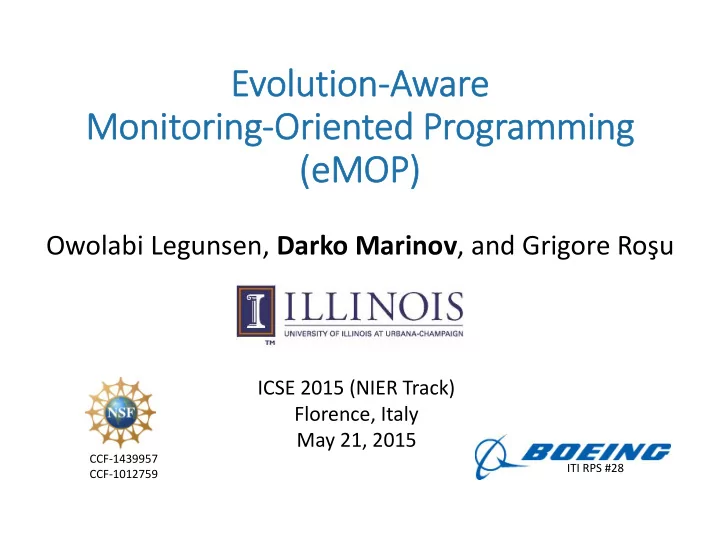

Evolution-Aware Monitoring-Oriented Programming (eMOP) Owolabi Legunsen, Darko Marinov , and Grigore Roşu ICSE 2015 (NIER Track) Florence, Italy May 21, 2015 CCF-1439957 ITI RPS #28 CCF-1012759
Monitoring-Oriented Programming (MOP) Runtime monitoring of software against formal properties • Existing technique targeted at single program version Code Code Violation * Runtime Runtime MOP MOP Monitors Monitors Property Property … Property Property Problems: High overhead and too many violations shown during evolution across many versions 2
Evolution-Aware MOP (eMOP) Make MOP faster and show fewer violations during evolution • Proposed Code Code Changes Changes Violation * Runtime Runtime MOP MOP Monitors Monitors Property Property … Property Property Tests Tests 3
Input: (Potentially Buggy) Code 1 public boolean m(List a, List b) { 2 ... 3 for(Iterator i = a.iterator(); i.hasNext();){ 4 ... 5 for(Iterator i2 = b.iterator(); i.hasNext();){ 6 ... i2.next() ... 7 } 8 } return ... 9 } Line 5 should be i2.hasNext() Mimics two real bugs found in older AspectJ code 4
Input: Formally Specified Properties 1. When to fire Events after Iterator. hasNext() == true, before Iterator. next() 2. Specification over Events Iterator.hasNext() == true precedes every Iterator.next() 3. Handler code User-defined action when specification is violated Many properties can be monitored at once 5
Output 1 public boolean find(List a, List b) { 2 ... 3 for(Iterator i = a.iterator(); i.hasNext();){ 4 ... 5 for(Iterator i2 = b.iterator(); i.hasNext();){ // event: “before Iterator.next()” 6 ... i2.next() ... 7 } 8 } return ... 9 } Violation: next() was called without calling hasNext() 6
Current State of MOP Research • Many papers, focus on reducing runtime overhead • Many bugs found in well-used, well-tested code • All prior research focused on one version • Recurring costs of monitoring are high, e.g., Run Properties Total Time(s) Monitored Violations No MOP v1 n/a n/a 8.4 MOP v1 180 27,895 164.1 MOP v2 180 27,904 231.8 7
Evolution-Aware MOP (eMOP) • Improve MOP during software evolution • Faster: re-monitor based on parts affected by changes • Show fewer violations: show only violations due to changes • We propose three techniques • Can be used separately or combined • Property selection • Monitor selection • Test selection 8
Technique: Property Selection • What subset of properties to re-monitor in new version? • Preliminary evaluation by seeding i2.next() bug : • Only Iterator_HasNext is affected by changes Run Properties Properties HasNext Total Time(s) Monitored Violated Violations Violations No MOP v1 n/a n/a n/a n/a 8.4 MOP v1 180 6 0 27,895 164.1 MOP v2 180 7 9 27,904 231.8 eMOP v2 1 1 9 9 8.8 9
Technique: Monitor Selection • Generate monitors for parts of code affected by change • Example: Foo.java and Bar.java both use Iterator Do not generate Do not generate Iterator_HasNext Iterator_HasNext Monitors Monitors Foo.java Foo.java Foo.java Foo.java changes changes Bar.java Bar.java Bar.java Bar.java Generate Generate Iterator_HasNext Iterator_HasNext Monitors Monitors New Version Old Version 10
Technique: Test Selection (MOP + RTS) • In eMOP we monitor execution of tests • RTS selects subset of tests that can be affected by code changes • If fewer tests are run, fewer violations and less overhead 11
Some Challenges • Safely determining properties/monitors/tests that can’t have new violations • Non-determinism, e.g., In these versions, the same tests are run, but different number of violations 12 12
Conclusions • All prior research on MOP targeted single code versions • eMOP aims to adapt MOP to software evolution • Make MOP faster between versions of software • Show only violations due to changes between versions • We proposed three techniques for eMOP • Property selection • Monitor selection • Test selection 13
Recommend
More recommend